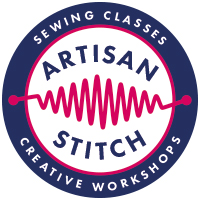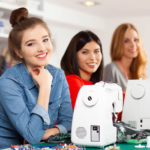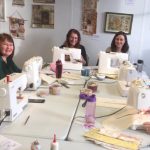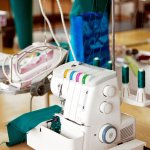How to practice safe sewing.
Are you practising safe sewing? If you’ve been using a sewing machine for a while and are completely comfortable with them, it’s easy to be blasé. But remember sewing machines are electrical devices and are potentially dangerous. You could also cause damage to your machine by incorrect use.
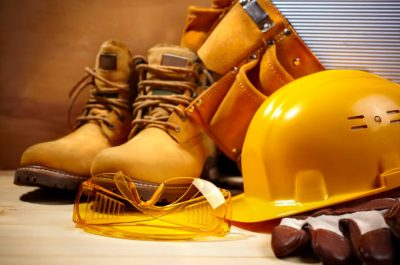
Firstly, take care of the machine itself. If you use an office-type chair, be careful not to roll over the power cable or foot-control cable, as this can fray or damage the cable. (Guilty as charged, and it was an expensive repair!)
Store the machine in a dry place, preferably in its hard case. If it wasn’t supplied with a case or cover, then buy (or make) a protective cover or bag (watch here for a downloadable pattern). Moisture and dust can seriously damage your machine. Also make sure you oil your machine in accordance with the manufacturer’s recommendations. Modern machines are often self-lubricating so don’t be splurging oil everywhere but much older machines do need frequent oiling, and the manual will tell you where to oil and how often. Inappropriate oiling can damage your machine, or at best, leak all over your fabric. If you’ve not used your machine for a while (months or even years), don’t haul it out and expect it to jump into action straightaway. There’s one thing sewing machines dislike and that’s neglect. If it’s been in a garage or a room that’s very cold, then bring it into a warm room and give it time to warm up first. The metal parts will thank you for it. Check for a build up of dust or dirt around the bobbin and needle area, and give it a little oil (see the manual).
Other electrical faults can occur by incorrect changing of the bulb. Consult your manual and use the recommended bulb for your specific model. Also be careful changing it and don’t pull or tug to remove it if it’s a bit tight. Make sure you know whether it’s a screw or a bayonet type before you try to remove it! The bulb may be very hot so be careful if you’re putting your hands anywhere near the light area.
To keep your machine in good working order, clean it regularly and remove any build-up of fluff and lint with the brush supplied, or a soft clean artist’s paint brush. Never poke at the machine workings with needles, pins, scissors or anything else not designed for that purpose. If you get lint or threads caught in your machine (or suspect that is the problem) and you can’t remove them easily yourself, take it to an authorised dealer for cleaning and servicing.
Finally the obvious danger; stitched fingers! If you need to hold a piece of small fabric or trim close to the stitching area while you are working, pin/tack or glue it down before stitching, or use a cocktail stick or skewer to hold the item while you stitch it. When doing free-motion embroidery work, using a darning or specialist embroidery foot will prevent your fingers getting too near. When threading the machine, changing needles, presser feet etc, always keep your hands to the side away from the needle where possible and place your feet flat on the floor, away from the foot control. Even better, switch off the machine.
If you care for your machine, and take the safety precautions described, not only will your machine function better and last longer, but you’ll avoid potential injury and sewing will be more fun!
To learn how to use a sewing machine, understand what makes them tick, how to care for your machine, and lots of other useful safe sewing tips, take one of my Beginners sewing classes.
